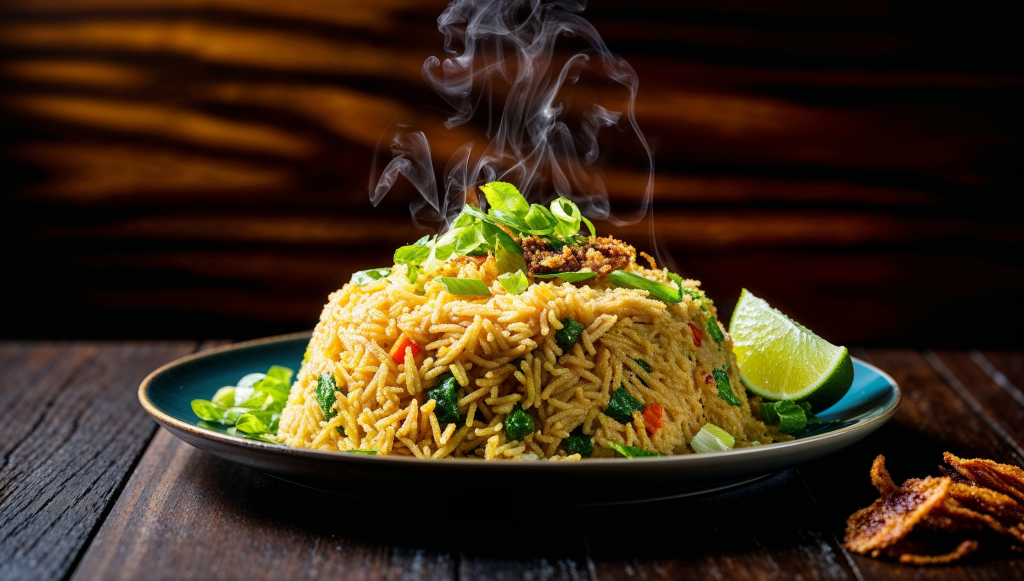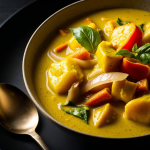Vegetarian Thai Fried Rice Recipe
This vegetarian Thai fried rice, or Khao Pad, is a vibrant and flavorful dish that can be customized in many ways. It’s quick to prepare and perfect for using up leftover vegetables and rice. Below is a tasty recipe along with creative variations, tips for making it low-carb, spicier, and suggestions for the best vegetables to include.
Ingredients
- 2 tablespoons oil (vegetable or sesame)
- 1 medium onion, diced
- 1 carrot, diced
- 1 bell pepper (red or green), diced
- 1 cup broccoli florets
- 2 small tomatoes, sliced
- 2 green onions, chopped
- 2 cloves garlic, minced
- 3 cups cooked jasmine rice (preferably cold)
- 2 tablespoons mushroom soy sauce (or substitute with regular soy sauce)
- 1.5 tablespoons light soy sauce
- 0.5 tablespoons white sugar
- Optional: fresh herbs (like Thai basil), chili flakes, or sriracha for heat
Instructions
- Prepare Ingredients: Dice all vegetables into small pieces to ensure they cook quickly and evenly.
- Heat the Pan: Preheat a non-stick wok or skillet over medium-high heat. Add the oil and coat the bottom of the pan.
- Cook Vegetables: Add the diced onion, carrot, and bell pepper. Stir-fry for about 3-4 minutes until they begin to soften.
- Add Garlic and Broccoli: Stir in minced garlic and broccoli florets, cooking for another minute until fragrant.
- Incorporate Sauces: Pour in the mushroom soy sauce, light soy sauce, and sugar, mixing well with the vegetables.
- Add Rice: Add the cold rice to the pan, breaking up any clumps with a spatula. Stir-fry for an additional 3-4 minutes until heated through.
- Garnish and Serve: Remove from heat and garnish with chopped green onions and fresh herbs. Serve hot with optional chili flakes or sriracha for added spice.
Creative Variations of Vegetarian Thai Fried Rice
- Thai Basil Fried Rice: Add a generous amount of fresh Thai basil leaves during the last minute of cooking for an aromatic flavor boost.
- Pineapple Fried Rice: Toss in fresh pineapple chunks for a sweet and tropical twist.
- Cashew Fried Rice: Mix in toasted cashews for added crunch and flavor.
- Spicy Fried Rice: Incorporate a tablespoon of homemade Thai red curry paste or extra chili flakes to amp up the heat.
- Tofu Fried Rice: Add pan-fried tofu cubes for protein; simply stir-fry them before adding other ingredients.
Low-Carb Option
You can definitely use cauliflower rice as a low-carb alternative to traditional rice. Simply pulse cauliflower florets in a food processor until they resemble rice grains, then sauté them in the same way you would with regular rice.
Making It Spicier
To make your Thai fried rice spicier:
- Add more chili flakes or fresh chopped Thai chiles.
- Drizzle sriracha or another hot sauce on top before serving.
- Mix in a tablespoon of sambal oelek or chili paste during cooking.
Best Vegetables to Add
Some great vegetable options include:
- Broccoli
- Snow peas
- Green beans
- Baby corn
- Mushrooms
- Zucchini
- Spinach or kale
These can be mixed and matched based on your preferences or what you have on hand.
Substituting Mushroom Soy Sauce
If you don’t have mushroom soy sauce, you can substitute it with:
- Regular soy sauce (for a less intense flavor)
- Tamari (for gluten-free)
- Liquid aminos (for a similar umami flavor)

Unique Protein Sources for Vegetarian Thai Fried Rice
When making vegetarian Thai fried rice, you can enhance the dish’s nutritional value and flavor by incorporating unique protein sources. Here are some options:
- Tofu: Firm or extra-firm tofu can be cubed and sautéed until golden brown. It absorbs flavors well and adds a satisfying texture.
- Tempeh: This fermented soy product has a nutty flavor and a firm texture. It can be crumbled or sliced and stir-fried with the vegetables for added protein.
- Edamame: These young soybeans are rich in protein and can be added directly to the fried rice for a pop of color and nutrition.
- Chickpeas: Canned or cooked chickpeas can be tossed into the rice for a hearty addition that provides fiber and protein.
- Lentils: Cooked lentils can be mixed into the fried rice for a protein boost, particularly red or green lentils that cook quickly.
- Quinoa: This pseudo-grain is high in protein and can be used as a base instead of rice, adding a unique texture and flavor.
Achieving a Smoky Flavor in Thai Fried Rice
To infuse your Thai fried rice with a smoky flavor, consider the following techniques:
- Use Smoked Oil: Cooking with smoked sesame oil or smoked olive oil can impart a deep, smoky flavor to your dish.
- Char Your Ingredients: Sauté vegetables like bell peppers or onions until they are slightly charred before adding them to the rice.
- Add Liquid Smoke: A few drops of liquid smoke can give your fried rice an intense smoky flavor without altering the dish’s consistency.
- Grill Ingredients: If possible, grill your tofu or vegetables before adding them to the fried rice for an authentic smoky taste.
Popular Thai Sauces for Fried Rice
Incorporating various sauces can elevate your vegetarian Thai fried rice:
- Soy Sauce: A staple in many Asian dishes, it adds saltiness and umami.
- Oyster Sauce: Vegetarian oyster sauce made from mushrooms provides depth and sweetness.
- Fish Sauce: For those who consume fish products, it adds a distinct salty umami flavor (can be substituted with soy sauce for vegetarians).
- Sriracha or Chili Paste: For heat and additional flavor, these sauces can be drizzled on top or mixed in during cooking.
- Sweet Soy Sauce (Kecap Manis): This thick, sweet sauce adds both sweetness and color to the dish.
Using Quinoa as a Gluten-Free Alternative
You can definitely use quinoa instead of traditional rice for a gluten-free version of Thai fried rice. Quinoa is high in protein and fiber, making it a nutritious substitute. To prepare:
- Rinse 1 cup of quinoa under cold water.
- Cook it according to package instructions (usually 2 cups of water for 1 cup of quinoa).
- Once cooked, fluff with a fork and let it cool before adding it to your stir-fry.
Tips for Making Crispy Thai Fried Rice
Achieving that perfect crispy texture in your Thai fried rice involves several key techniques:
- Use Day-Old Rice: Refrigerated rice dries out slightly, which helps prevent mushiness when stir-fried.
- Spread the Rice Evenly: When frying, spread the rice out in an even layer in the pan to allow it to toast properly without steaming.
- High Heat Cooking: Use high heat while stir-frying to quickly sear the ingredients without overcooking them.
- Avoid Overcrowding the Pan: If making a large batch, cook in smaller portions to maintain high heat and ensure even cooking.
- Let It Sit: After adding the rice, let it sit undisturbed for a minute before stirring to allow some grains to crisp up at the bottom.
By incorporating these unique protein sources, flavors, and techniques, you can create an exciting vegetarian Thai fried rice that stands out in taste and texture!
This recipe is versatile and allows for creativity while being quick to prepare, making it an excellent choice for any weeknight dinner! Enjoy experimenting with different flavors and ingredients!

